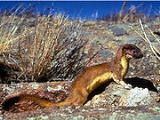
Musteloidea
Encyclopedia
Musteloidea is a superfamily
of carnivora
n mammal
s united by shared characters of the skull and teeth. Musteloids share a common ancestor with the pinniped
s, the group which includes seal
s.
The Musteloidea consists of the families Ailuridae (red pandas), Mustelidae (mustelids: weasels), Procyonidae (procyonids: raccoons and kin), and Mephitidae (skunks).
In North America
, ursoids and musteloids first appear in the Chadronian (late Eocene
). In Europe
, ursoids and musteloids first appear in the early Oligocene
immediately following the Grande Coupure.
The superfamily
Musteloidea may not be a monophyletic group. Some or all of the diagnostic characters could have evolved into two or more independent radiations from primitive ursoids such as Amphicynodon
.
Family (biology)
In biological classification, family is* a taxonomic rank. Other well-known ranks are life, domain, kingdom, phylum, class, order, genus, and species, with family fitting between order and genus. As for the other well-known ranks, there is the option of an immediately lower rank, indicated by the...
of carnivora
Carnivora
The diverse order Carnivora |Latin]] carō "flesh", + vorāre "to devour") includes over 260 species of placental mammals. Its members are formally referred to as carnivorans, while the word "carnivore" can refer to any meat-eating animal...
n mammal
Mammal
Mammals are members of a class of air-breathing vertebrate animals characterised by the possession of endothermy, hair, three middle ear bones, and mammary glands functional in mothers with young...
s united by shared characters of the skull and teeth. Musteloids share a common ancestor with the pinniped
Pinniped
Pinnipeds or fin-footed mammals are a widely distributed and diverse group of semiaquatic marine mammals comprising the families Odobenidae , Otariidae , and Phocidae .-Overview: Pinnipeds are typically sleek-bodied and barrel-shaped...
s, the group which includes seal
Pinniped
Pinnipeds or fin-footed mammals are a widely distributed and diverse group of semiaquatic marine mammals comprising the families Odobenidae , Otariidae , and Phocidae .-Overview: Pinnipeds are typically sleek-bodied and barrel-shaped...
s.
The Musteloidea consists of the families Ailuridae (red pandas), Mustelidae (mustelids: weasels), Procyonidae (procyonids: raccoons and kin), and Mephitidae (skunks).
In North America
North America
North America is a continent wholly within the Northern Hemisphere and almost wholly within the Western Hemisphere. It is also considered a northern subcontinent of the Americas...
, ursoids and musteloids first appear in the Chadronian (late Eocene
Eocene
The Eocene Epoch, lasting from about 56 to 34 million years ago , is a major division of the geologic timescale and the second epoch of the Paleogene Period in the Cenozoic Era. The Eocene spans the time from the end of the Palaeocene Epoch to the beginning of the Oligocene Epoch. The start of the...
). In Europe
Europe
Europe is, by convention, one of the world's seven continents. Comprising the westernmost peninsula of Eurasia, Europe is generally 'divided' from Asia to its east by the watershed divides of the Ural and Caucasus Mountains, the Ural River, the Caspian and Black Seas, and the waterways connecting...
, ursoids and musteloids first appear in the early Oligocene
Oligocene
The Oligocene is a geologic epoch of the Paleogene Period and extends from about 34 million to 23 million years before the present . As with other older geologic periods, the rock beds that define the period are well identified but the exact dates of the start and end of the period are slightly...
immediately following the Grande Coupure.
The superfamily
Taxonomic rank
In biological classification, rank is the level in a taxonomic hierarchy. Examples of taxonomic ranks are species, genus, family, and class. Each rank subsumes under it a number of less general categories...
Musteloidea may not be a monophyletic group. Some or all of the diagnostic characters could have evolved into two or more independent radiations from primitive ursoids such as Amphicynodon
Amphicynodon
Amphicynodon is an extinct genus of mammal of the superfamily Ursoidae, endemic to Europe and Asia during the Oligocene, living from ~33.9—28.4 Mya, existing for approximately ....
.

